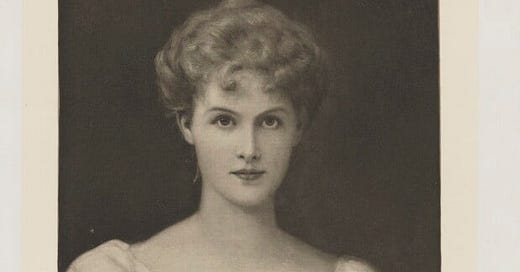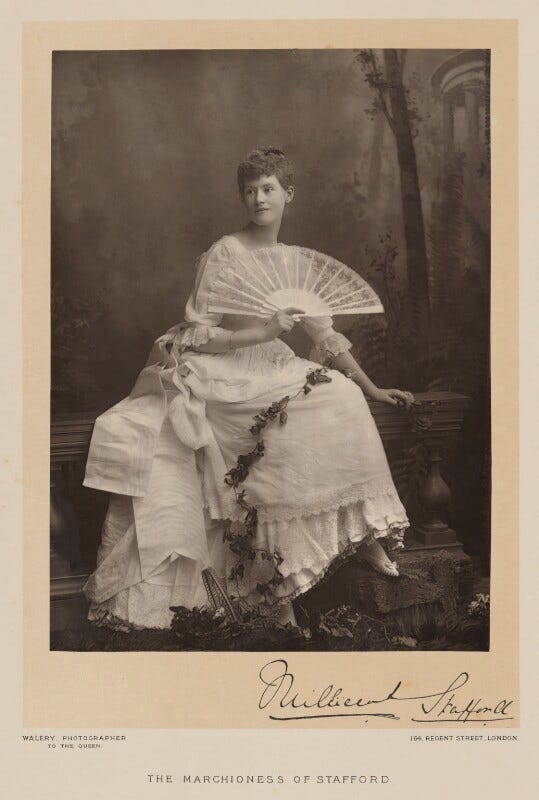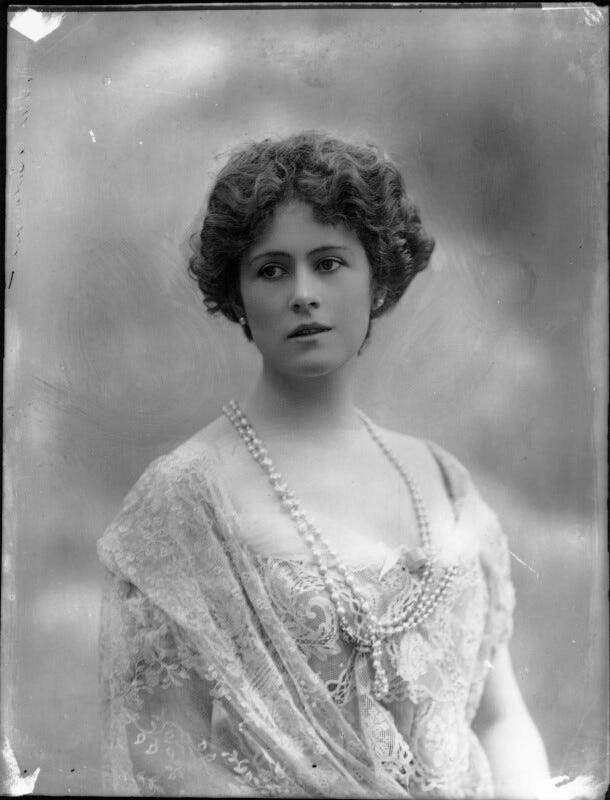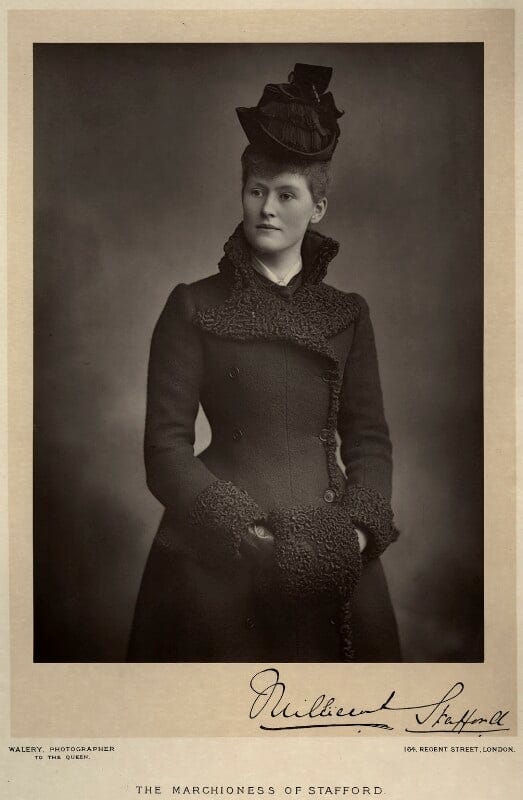The fascinating story of the Duchess of Sutherland
Delving into Millicent Laura Leveson-Gower's life
Happy Sunday and welcome back to Giselle daydreams! Today’s post is influenced by Madrid’s Golden Triangle of Art, in which I included a portrait of the Duchess of Sutherland in my highlights from the Thyssen Museum. Afterwards, I researched the sitter and realised the Duchess of Sutherland had a lifetime story worth writing about. Therefore, I decided to dedicate a post about her.
Millicent, Duchess of Sutherland (née Millicent Laura Leveson-Gower), was a British aristocrat and socialite. She was born on 29 March 1867 into the prominent Leveson-Gower family, which held significant influence in British society. She was the daughter of the 4th Earl Granville and his wife, Lady Rosalie, the daughter of the 4th Duke of Wellington. Her family was deeply embedded in the British aristocracy, with connections to royalty and the highest social circles. Growing up in such a prestigious environment, she was educated in the arts, etiquette, and social responsibility, preparing her for a prominent role in society. Besides being known for her beauty and her significant influence on society, she played an important role in charitable endeavours and the cultural landscape of her time. Her legacy is tied to her aristocratic lineage and her involvement in both charitable work and cultural circles, where she was a prominent figure during the late 19th and early 20th centuries.
Becoming the Duchess of Sutherland
On 20 October 1884, as she turned 17, Millicent married Hugh Grosvenor, 4th Duke of Sutherland, a marriage which cemented her status in the British aristocracy. Hugh was the heir to one of the wealthiest and most powerful aristocratic families in Britain, with vast estates across England and Scotland, including Dunrobin Castle in the Scottish Highlands. The marriage was likely arranged for social and economic reasons, as was typical for aristocratic unions of the time, but it also placed Millicent at the centre of high society.
Millicent became known as the Duchess of Sutherland, taking on a role that combined managing the family estates with participating in public life. As the wife of the Duke, she played a central role in overseeing the family's philanthropic activities and engaging in social events that involved the British elite. Millicent was also noted for her connections with the art world. She was a patron of the arts and was involved in the social and cultural life of her era. Her role as a patron aligned with her noble status, allowing her to host important events and support the development of various artistic initiatives.
The couple lived at Dunrobin Castle, an impressive estate in the Scottish Highlands. The castle, which is still a family residence, became an important symbol of the family's power and wealth. Millicent, as the Duchess, was deeply involved in managing the estate, which included overseeing the well-being of tenants and supporting local communities. Dunrobin Castle housed extensive art collections and became a hub for various social and cultural events.
She was more than one of England's greatest beauties and celebrated society hostess.
The Duchess was known for her legendary soirées and social gatherings at her family seat, Dunrobin Castle. These events were attended by leading figures of the time, including members of the royal family, politicians, and other aristocrats. She had a reputation for hosting these events with grace and sophistication, making her a central figure in social circles. In addition to her aristocratic duties, Millicent was also a fashion icon. Known for her impeccable style, she was often featured on the social pages of the time. She wore the latest fashions by renowned designers, setting trends among high society in London and beyond.
While many knew her for her noble status and socialite presence, Millicent was deeply involved in various charitable works, especially in the fields of education and the arts. Her philanthropy extended to supporting schools and hospitals, often without seeking recognition.
Millicent played a significant role in curating and expanding the art collection at Dunrobin Castle, the seat of the Dukes of Sutherland in Scotland. This collection, which included works from the Italian Renaissance and Old Masters, was not only a private treasure trove but also a reflection of her own cultivated tastes and support for art and culture. Through her marriage and later as the Duchess, Millicent had an influence on the development and preservation of Scottish heritage. She helped to fund various initiatives related to Scottish history, particularly in relation to the Sutherland family’s extensive estates.
Millicent’s social standing meant she was closely connected with the British royal family, and she was particularly admired by Queen Victoria. The Queen often praised her for her beauty and elegance, and Millicent's presence was highly valued in royal circles.
The Duchess in images
The Duchess of Sutherland was a prominent figure in British aristocratic circles, and as such, she was depicted in both paintings and photographs. Like many aristocrats, Millicent was often depicted in formal portraits emphasising her high social status. These portraits typically feature her in elaborate gowns, with the backdrop of opulent estates or in interiors showcasing wealth and taste. These artworks reflect her beauty, status, and role in society.
Her portrait by John Singer Sargent is a delight to look at.
The sitter, the Duchess of Sutherland, was a celebrated figure in London society, known for her progressive ideals and striking presence. In this portrait, Sargent captures her commanding elegance within the dappled shade of a garden. With one hand resting gracefully on a fountain, she wears a green floral-patterned dress with a low neckline, her red hair adorned with a laurel leaf tiara that suggests a connection to the natural world surrounding her. The composition draws inspiration from the great masters Sargent admired, including Velázquez and Van Dyck, as well as the refined tradition of 18th-century English portraiture.
Given her prominence, Millicent was often the subject of fashionable portrait photography. There are several black-and-white photographs from the late 19th and early 20th centuries that feature Millicent as a young woman and others from her later years, always looking regal. Some of these images show her in formal poses, either alone or with her family, highlighting her role as a central figure in British society. These Victorian and Edwardian photographs capture her elegance and poised demeanour, often taken during social events or gatherings at her family estate, Dunrobin Castle.
A philanthropist beyond the spotlight
Millicent was deeply involved in philanthropic activities, particularly focused on education, the arts, and healthcare. She was known for her quiet, behind-the-scenes contributions to charitable causes. Millicent’s role as a patron of women's education and children's welfare is often mentioned, although her extent of activism was not as publicly prominent as that of other notable suffragists, she was privately supportive of the women's suffrage movement in Britain. Her influence and social standing allowed her to help pave the way for greater involvement of women in the arts and public life, even indirectly.
She was also a passionate advocate for social reform and a published author. When World War I broke out, she took a Red Cross ambulance unit to France and established the No. 9 Red Cross Hospital. In August 1914, she was captured by the Germans but managed to escape. The Duchess continued her service with the Red Cross in France for the duration of the war. In 1917, King George V and Queen Mary visited her hospital in Calais as part of the king’s tour of the French battlefields.
The legacy of the Duchess of Sutherland
Millicent and Hugh’s marriage had its challenges, including the pressures of managing such an immense estate and the demands of aristocratic life. The couple had four children, but unfortunately, only one son survived until late adulthood. After the Duke of Sutherland's death in 1913, Millicent continued to play a role in the family’s affairs, though much of the responsibility was passed on to the Duke’s heirs. She lived through significant changes in British society, including the decline of the traditional aristocracy, the rise of women's rights, and the aftermath of World War I. She married again, twice. Although Millicent’s private life remains somewhat under explored, it is clear that her position as a mother and wife was integral to her identity.
While Millicent may not be as widely remembered today as some of her contemporaries, she was an influential figure in her time. She helped shape the cultural and philanthropic legacy of the Sutherland family. Her influence as a patron of the arts, a hostess of high-society events, and a figure in charitable work contributed to the shaping of the social fabric of late Victorian and Edwardian Britain.
Millicent's life, characterised by a blend of grace, responsibility, and active participation in the cultural and social events of her time, remains a testament to the role of women in the aristocracy during a period of transition in British society. Millicent passed away in 1955 in France. Her death marked the end of an era for the Sutherland family’s involvement in British aristocratic life.
For those interested in reading more, Dear Duchess: Millicent Duchess of Sutherland, 1867-1955 by Denis Stuart (1972) will feed your curiosity.
FIN.
Thank you for reading this post. If you enjoyed it, please like, comment, share and subscribe. It helps the newsletter grow.










Interesting
I feel like I just watched 6 seasons of Downton Abbey! Most love the Sargent portrait and the fact she was a ginger always running the show.